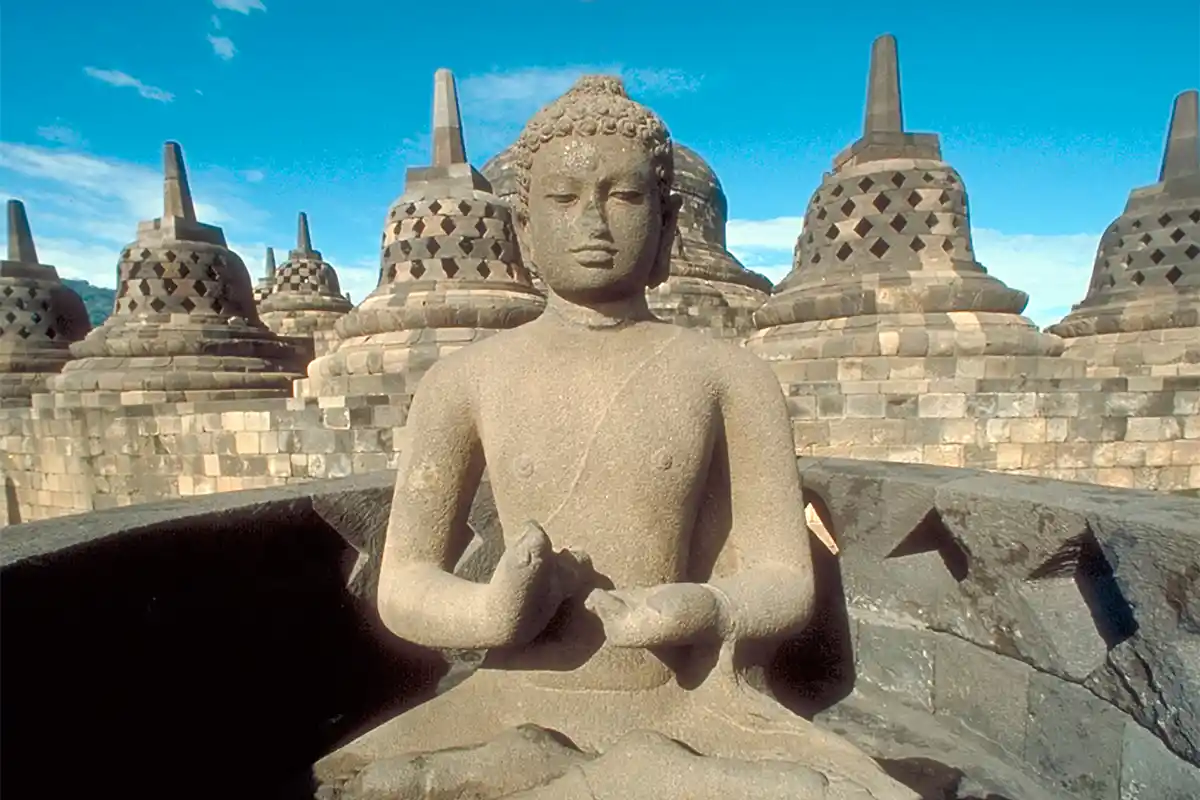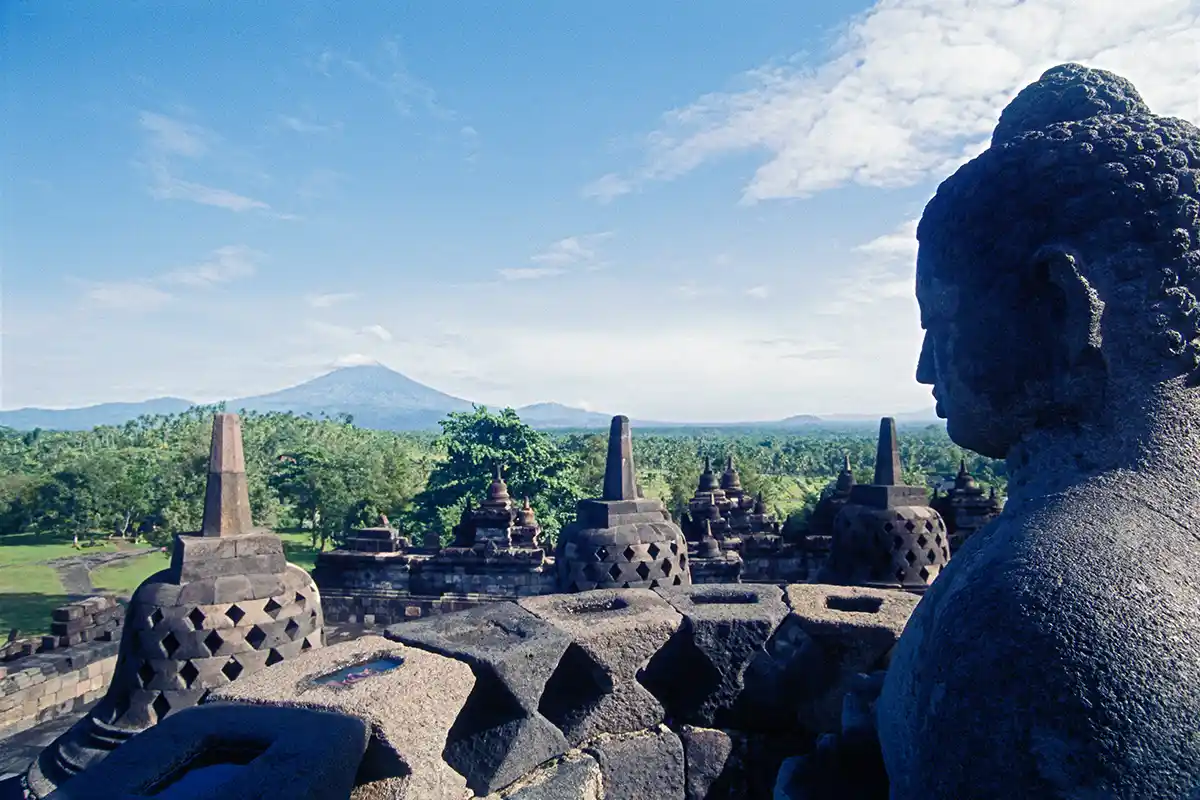Borobudur Stupa, Java
Sometime before the 5th century AD, the influence of Hinduism and Buddhism spread southward from the mainland of southeast Asia to the islands of Sumatra, Java, Bali, and a few others in the archipelago currently called Indonesia. It is misleading to think of all of Indonesia as an ancient empire or the province of any particular religion. The vast archipelago of over 13,000 islands became the nation of Indonesia in 1949, and only a few of its major islands were ever settled or influenced by Hinduism, Buddhism, or Islam.
There are no archaeological remains of temples in the Indianized states of Java before the end of the 7th century because the early Hindu structures were built of wood and have long since decayed in the moist tropical climate. The first stone temples, Shiva shrines constructed during the 8th century, are found high on the Dieng plateau, the name Dieng meaning 'the place of the gods.' However, the greatest concentration of Javanese sacred architecture lies on the plain of Kedu, some 42 kilometers northwest of Yogyakarta. Here stands Prambanan's beautiful Hindu temple complex and the world-famous Hindu/Buddhist temple of Borobudur.
Borobudur, a name deriving from an expression meaning 'Mountain of accumulation of merits of the ten states of Bodhisattva,' is commonly thought of as a Buddhist structure. However, there is no known record of the construction of the Borobudur temple. Different historians have made assumptions about it based on oral traditions, architectural construction styles, interpretations of carved reliefs on the lower levels of the temple, inscriptions used in royal charters in the 8th and 9th centuries, and mentions of the Sanjaya and Sailendra Dynasties in the records of other states. Therefore, much of what different historians claim is based on conjecture. What is reasonably sure is that there were various dynastic families in Central Java from the 8th to 13th centuries, predominant among them being the Sailendra, and that the Hindu and Buddhist faiths mostly coexisted peacefully.
The initial construction of the structure was planned and conducted by the Hindu Sanjaya dynasty sometime around 775 AD. The enormous first and second terraces were erected as a Shiva temple by the Sanjaya, and then construction was halted for some years. Why the construction temporarily happened is unknown, though some scholars have suggested a change in the religious orientation of the dynasties - from the Hinduism of the Sanjaya to the Buddhism of the Sailendra. From 790 to 835 AD, the Buddhist Sailendra Dynasty continued building the structure as a great stupa, adding three more levels.
During the 10th and 11th centuries, power was transferred from central Java to the east, and the great stupa fell into decline. For centuries, the site lay forgotten under layers of volcanic ash and jungle growth. In 1815, Europeans cleared the site, in the early 1900s, the Dutch began its restoration, and a US$21 million project began in 1973 to complete the work.
The Borobudur stupa sits upon a low sculptured hill and is a massive symmetrical step pyramid, 403 feet (123 meters) on each side and 105 feet high ( 32 meters). Constructed of over two million blocks of grey andesite and volcanic basalt stone, it was built without cement or mortar.
The monument represents a Buddhist cosmological model of the universe organized around the axis of the mythical Mount Meru. Beginning at the eastern gateway, pilgrims circumambulate the stupa, always in a clockwise direction. Walking through nearly five kilometers of open-air corridors while ascending through six square terraces and three circular ones, the pilgrim symbolically spirals upward from the everyday world to the nirvanic state of absolute nothingness.
The first six terraces are filled with richly decorated relief panels in which the sculptors have carved a textbook of Buddhist doctrines and a fascinating panorama of 9th-century Javanese life. The monument, the largest and most complete ensemble of Buddhist reliefs in the world, is decorated with 2,672 relief panels and 504 Buddha statues. Upon the upper three terraces are 72 small stupas, each containing a statue of the Buddha (these statues are usually headless; relic hunters stole many of the heads, others are in museums).
Seen from high above the temple forms a mandala, a three-dimensional model of the Mahayana Buddhist universe. The temple levels symbolize the three divisions of the religion’s cosmic system, and the climb to the top is intended to illustrate the path an individual must take to reach enlightenment. Visitors make their way through the three levels of Buddhist cosmology:
- Kamadhatu (the world of desire)
- Rupadhatu (the world of forms)
- Arupadhatu (the world of formlessness)
Crowning the entire structure is a central stupa. Representing Nirvana, it is empty.

Martin Gray is a cultural anthropologist, writer and photographer specializing in the study of pilgrimage traditions and sacred sites around the world. During a 40 year period he has visited more than 2000 pilgrimage places in 160 countries. The World Pilgrimage Guide at sacredsites.com is the most comprehensive source of information on this subject.


